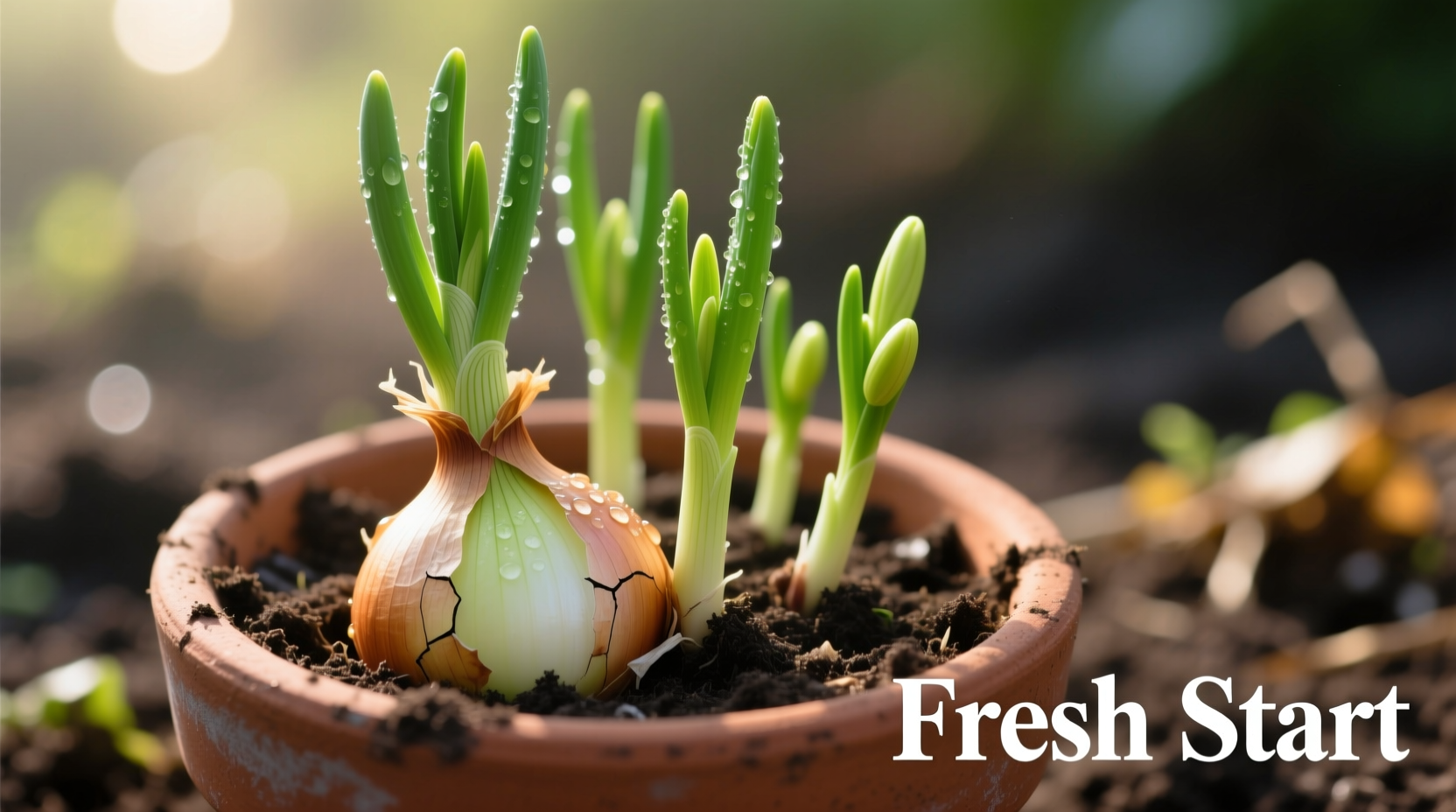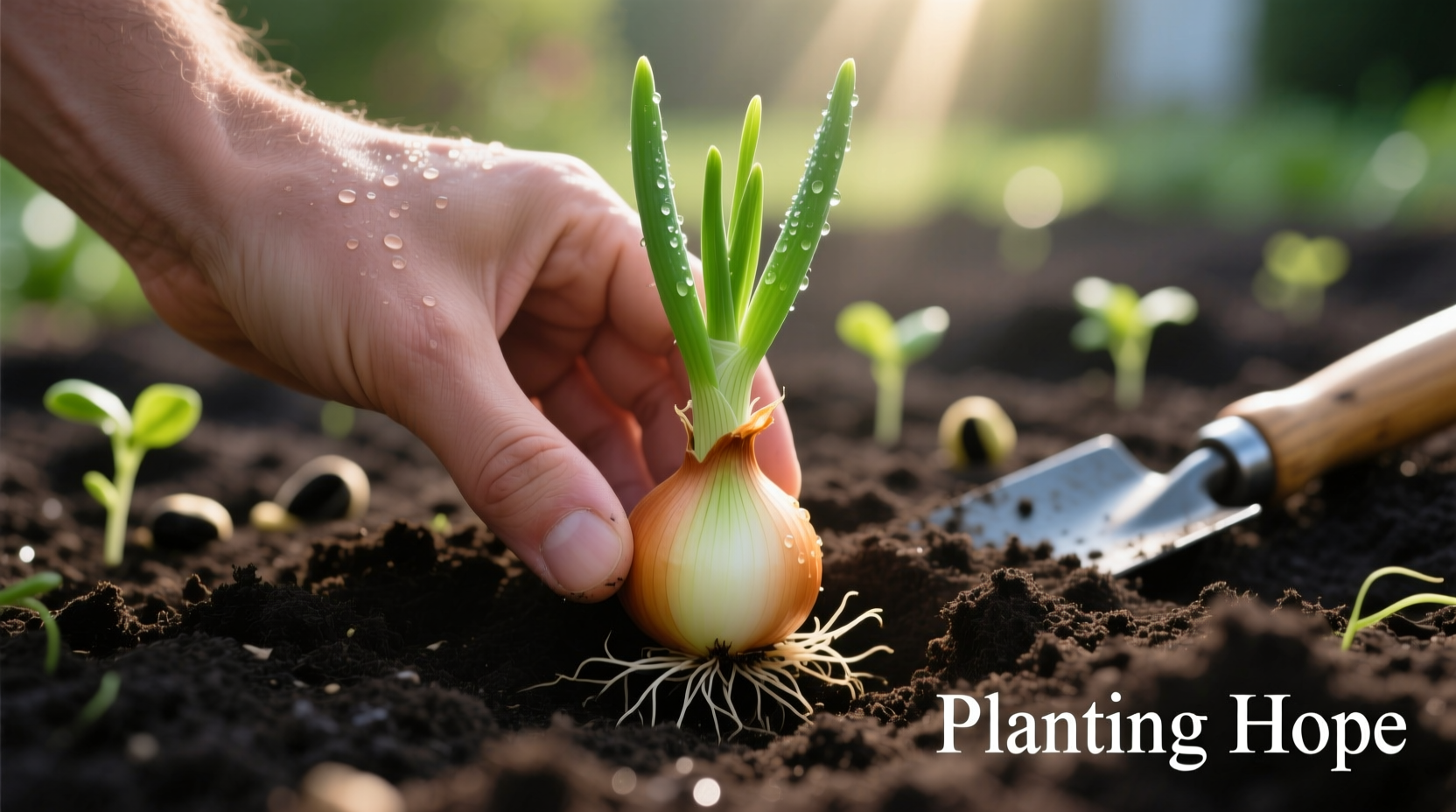Why Your Sprouted Onion Is Ready for Planting
That green shoot emerging from your stored onion isn't a sign of spoilage - it's nature's signal that your onion is primed for growth. When onions sprout, they're activating their natural reproductive cycle. The green shoot contains chlorophyll and begins photosynthesis immediately, giving your plant a significant head start compared to planting from seed.
University of California Cooperative Extension research confirms that sprouted onions maintain 85-90% of their original nutritional value while developing new growth potential. This makes them ideal candidates for home propagation, especially during spring planting season when daylight hours increase.
Step-by-Step Planting Process
Follow these precise steps for successful onion propagation:
1. Selecting Viable Sprouted Onions
Not all sprouted onions make good planting candidates. Choose onions that:
- Have firm, crisp bulbs without soft spots
- Show 1-3 inches of green growth
- Feel heavy for their size (indicating moisture retention)
- Have intact root plates (the flat bottom where roots emerge)
Discard any onions showing mold, excessive softness, or sulfur-like odors. According to USDA storage guidelines, onions stored below 45°F (7°C) with 65-70% humidity maintain viability longest before sprouting.
2. Preparing Your Sprouted Onion
Before planting, properly prepare your sprouted bulb:
- Cut the onion top 1 inch above the sprout using a clean knife
- Separate the green shoots if multiple have emerged
- Peel away any papery outer layers showing decay
- Soak the base in room-temperature water for 24 hours
This preparation process activates growth hormones while removing potential pathogens. Cornell University gardening experts recommend this soaking step to rehydrate bulbs that may have dried during storage.
| Planting Method | Time to Harvest Greens | Full Bulb Development | Best For |
|---|---|---|---|
| Whole Bulb Planting | 3-4 weeks | 60-90 days | Large storage onions |
| Top Section Only | 2-3 weeks | No bulb formation | Onions with soft bases |
| Root Plate Only | 4-5 weeks | 45-60 days | Partially decayed onions |
3. Soil and Container Preparation
Onions thrive in well-draining soil with pH between 6.0-6.8. For best results:
- Mix garden soil with equal parts compost and perlite
- Ensure containers have drainage holes (minimum 6" depth)
- Sunlight requirement: 6-8 hours daily
- Ideal planting temperature: 55-75°F (13-24°C)
Indoor growers should use south-facing windows or supplement with grow lights positioned 6 inches above plants. The Royal Horticultural Society notes that onions grown in temperatures below 50°F (10°C) may prematurely bolt (produce flowers), reducing bulb size.
4. Planting Your Sprouted Onion
Follow these precise planting instructions:
- Fill container with prepared soil to 1" below rim
- Create a 1" deep hole using your finger
- Place onion with root plate down, sprout facing up
- Cover with soil, leaving 1/3 of the sprout exposed
- Water thoroughly until drainage appears
Space multiple onions 4-6 inches apart in garden beds. The exposed portion of the sprout should remain above soil line to prevent rot while encouraging continued growth.

5. Ongoing Care Requirements
Maintain optimal growing conditions with these practices:
Watering Schedule
Keep soil consistently moist but not saturated. Water when top inch of soil feels dry. During hot weather, check daily. Overwatering causes root rot while underwatering stresses plants. The University of Minnesota Extension recommends 1 inch of water weekly, including rainfall.
Fertilizing Protocol
Apply balanced fertilizer (10-10-10) every 3-4 weeks. For organic options, use compost tea or fish emulsion. Stop fertilizing 30 days before expected harvest to improve storage quality.
Common Problems and Solutions
Address these frequent issues promptly:
- Yellowing leaves: Indicates nitrogen deficiency - apply balanced fertilizer
- Thin, weak growth: Needs more sunlight - move to brighter location
- White mold: Reduce watering and improve air circulation
- Purple leaf tips: Phosphorus deficiency - apply bone meal
Growth Timeline and Harvesting
Understanding your onion's development stages ensures proper harvesting:
- Days 1-7: Root development begins, minimal top growth
- Days 8-21: Rapid green shoot growth (harvest scallion-style)
- Days 22-45: Bulb formation begins, requires consistent moisture
- Days 46-60: Bulb enlargement phase, reduce watering slightly
- Days 61-90: Maturation phase, tops begin falling over
Harvest green onions when shoots reach 6-8 inches tall. For full bulbs, wait until tops naturally fall over and yellow. Carefully dig bulbs, cure in shaded, well-ventilated area for 7-10 days before storage.
Climate Considerations for Success
Onion varieties respond differently to day length. Understanding your region's requirements prevents planting failures:
- Short-day onions: Form bulbs with 10-12 hours daylight (Southern US)
- Intermediate-day: Require 12-14 hours daylight (Mid-latitude regions)
- Long-day onions: Need 14+ hours daylight (Northern US, Canada)
Planting the wrong variety for your region results in poor bulb formation. The USDA Plant Hardiness Zone Map helps determine appropriate planting times. In zones 3-5, plant in early spring; zones 6-10 can plant fall through early spring.
Maximizing Your Harvest
Extend your onion production with these professional techniques:
- Succession planting every 2-3 weeks for continuous harvest
- Trim green tops to 4" when 8" tall to encourage thicker regrowth
- Use harvested green tops immediately for maximum flavor
- Save healthy bulbs for replanting next season
According to Texas A&M AgriLife Extension, properly stored onions maintain viability for planting for up to 12 months when kept in cool, dry conditions. This creates a sustainable cycle where you can continuously propagate from your harvest.
Frequently Asked Questions
Can I plant any type of sprouted onion?
Most common storage onions (yellow, red, white) can be planted successfully. Avoid planting sweet onions or varieties specifically bred for immediate consumption, as they lack the genetic traits for robust regrowth. Pearl onions and multiplier varieties show particularly vigorous regrowth potential.
How soon after sprouting should I plant an onion?
Plant within 3-5 days of noticing sprouting for best results. Onions continue to deplete stored energy as they sprout, reducing viability over time. If immediate planting isn't possible, store sprouted onions in the refrigerator's crisper drawer with slightly damp paper towels to maintain moisture.
Will planting a sprouted onion produce a larger onion?
Typically no - the original bulb serves primarily as an energy source for new growth. Most gardeners harvest the green tops as scallions. In optimal conditions, the plant may form a new, smaller bulb. For larger bulbs, plant onion sets or seeds specifically bred for bulb production.
Can I grow onions from sprouted onions indoors year-round?
Yes, with proper lighting. Use LED grow lights providing 14-16 hours of light daily, positioned 6-12 inches above plants. Maintain temperatures between 60-75°F (15-24°C) and ensure good air circulation. Indoor-grown onions typically produce excellent green tops but rarely form substantial bulbs due to space limitations.
What's the difference between planting sprouted onions and onion sets?
Onion sets are intentionally grown small bulbs harvested specifically for replanting, while sprouted pantry onions are mature bulbs that began growing unintentionally. Sets have higher success rates (85-90%) compared to sprouted storage onions (60-70%) because they're bred for regrowth and haven't depleted energy reserves through extended storage.











 浙公网安备
33010002000092号
浙公网安备
33010002000092号 浙B2-20120091-4
浙B2-20120091-4